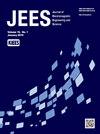Clutter Rejection for FM Ranging Airborne Radar
IF 1.7
3区 工程技术
Q3 ENGINEERING, ELECTRICAL & ELECTRONIC
Journal of electromagnetic engineering and science
Pub Date : 2023-10-30
DOI:10.26866/jees.2023.6.r.190
引用次数: 0
Abstract
In airborne radar, it is important to reject clutter signals to detect targets of interest. High pulse repetition frequency (HPRF) waveform provides robust detection performance in a clutter environment by separating clutter signals from the target echo signals in a Doppler frequency domain, but it suffers from range ambiguity. The range ambiguity in HPRF can be resolved by frequency modulation (FM) ranging. However, the Doppler frequencies of both the clutter and target echo signals change linearly with the range due to changes in the carrier frequency in FM ranging. In such a case, the target echo signal can be rejected by a conventional clutter rejection frequency even if it is not masked by a clutter signal. This paper proposes an optimum clutter rejection frequency for FM ranging airborne radar by considering the Doppler frequency spread in FM ranging. The optimum clutter rejection frequency is derived by calculating the maximum Doppler frequency of the spread clutter signal caused by FM ranging. The simulation and flight test results verify that the proposed clutter rejection frequency is the optimum value that can improve the detection capability of FM ranging airborne radar.调频测距机载雷达杂波抑制
本文章由计算机程序翻译,如有差异,请以英文原文为准。
求助全文
约1分钟内获得全文
求助全文
来源期刊

Journal of electromagnetic engineering and science
ENGINEERING, ELECTRICAL & ELECTRONIC-
CiteScore
2.90
自引率
17.40%
发文量
82
审稿时长
10 weeks
期刊介绍:
The Journal of Electromagnetic Engineering and Science (JEES) is an official English-language journal of the Korean Institute of Electromagnetic and Science (KIEES). This journal was launched in 2001 and has been published quarterly since 2003. It is currently registered with the National Research Foundation of Korea and also indexed in Scopus, CrossRef and EBSCO, DOI/Crossref, Google Scholar and Web of Science Core Collection as Emerging Sources Citation Index(ESCI) Journal. The objective of JEES is to publish academic as well as industrial research results and discoveries in electromagnetic engineering and science. The particular scope of the journal includes electromagnetic field theory and its applications: High frequency components, circuits, and systems, Antennas, smart phones, and radars, Electromagnetic wave environments, Relevant industrial developments.
 求助内容:
求助内容: 应助结果提醒方式:
应助结果提醒方式:


